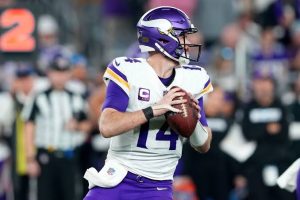Every draft presents strategic issues for GMs as they begin to pick or trade and pick.
Most of these issues have a basis point of where scouting grade meets supply and demand.
Essentially, there aren’t enough players graded at a particular position to meet a team’s need for talent at their particular point for selection. The solution can be moving up or moving back, depending on how they have assessed the elite talent pool or in later rounds, the level of talent overall.
In this draft, the Bears are facing several strategic problems based on the way analysts and media members have graded the talent in this draft. Of course, the Bears and the NFL might see it completely different when it comes to some of those grades.
For instance, former Bears college scouting director Greg Gabriel, who writes for Windy City Gridiron and does analysis across all platforms, said on “X” that he expects numerous surprises in this NFL draft because the talent level of players across the board appears to be closer at many positions than in many other recent years. The projected picks will be way off, he says.
At this point, we can only base picks on what could be and the strategic issues facing the Bears look like this.
1. The Gap
It’s there again just like always, it seems.
The Bears have three picks in the top 41 and actually they are the only team with four picks in the first 72. Having two second-round picks is a great asset.
However, the gap occurs after their 72nd pick in Round 3 on Day 2. They won’t pick again until Round 5, pick No. 148. They traded a fourth-rounder for Keenan Allen and what did they get out of it?
When 76 picks go past at this point in the draft, the level of talent is going to look like they’ve gone to another solar system to find it once they do start selecting again. That would be the solar system of athletically challenged.
As good as the talent is supposed to be in this draft at several positions, none of them will go all the way into Round 5.
Covering up that gap between pick No. 72 and No. 148 is something Poles must explore with trade backs. Maybe moving back off of 41 in Round 2, or perhaps a trade back from No. 72 to pick up a late fourth-rounder.
Last year the gap became the end of their draft. They had no picks left after Round 4 and the selection of punter Tory Taylor but Poles turned creative or maybe Ryan Pace-ish by borrowing against the future with the trade of a 2025 fourth-rounder so he could draft Austin Booker in Round 5.
Gaps must be filled. The Bears have one, even if they do have sufficient pick numbers early.
2. Quarterback/receiver deficiencies
The Bears can’t complain because there appears to be good talent at need areas like pass rushers, running backs and offensive linemen, but the lack of truly elite QBs and receivers is preventing a run in the early picks to get into position for the big grab. When that happens, it does more than anything else to drive talent at other positions back down toward the end of the top 10 where they are picking.
This is not the 2024 quarterback crop with six passers about to go in the top 12. This is not even the wide receiver crop, where three were going in the first nine. It’s not even like the 2022 draft, when no receivers went until the eighth pick but then six had been taken by No. 18.
When there isn’t this big glob of skill positions taken near the top, too many good linemen on both sides of the ball are probably getting taken where they should be drafted and this isn’t as good for the Bears’ cause this year.
3. A balanced line
This is more of an issue for those trying to figure out who the Bears will draft than for the team itself. The team is going to have its distinct grades on each of these linemen, anyway. But it’s not easy to see a lineman who stands out above the others because even the really good ones have apparent flaws. Will Campbell’s arm length has been beaten to death.
Armand Membou hasn’t been a left tackle and doesn’t have the classic length of one, although he seems to have everything else. The rest of the linemen grade out in a second 10 level in most mocks or on NFL Mock Draft Data Base.
It’s not an issue unless you’re taking 10th and you’re at that dividing point where there could be a gap in talent level for offensive linemen between No. 2 and No. 3 chosen.
The tackles lack that Joe Alt-Andrew Thomas, with the classic long reach, wing span and height. There is no all-universe Quenton Nelson at guard, but a lot of very good linemen.
4. Running Back Depth
It’s good, great in fact. There’s the problem. How far do you let it play out while looking at other positions before striking for that all-purpose back? If you wait too long, they might pass a barrier. There is only one Ashton Jeanty, and Omarion Hampton is probably a first-round talent, as well. After that, you’re moving back a little but there are so many backs thought to be capable of going from third through 12th at that position that it’s going to be a matter of how far do you dare keep taking pass rushers, safeties, even tight ends before committing to the ball carrier?
If the talent was very thin, the point to intervene would be far more obvious.
5. Edge Template
While the edge rusher and interior rush supply is as good as any in recent memory, the Bears are a team bound to a specific scheme. They need to fit the template on the edge of 260-288 pounds to make Dennis Allen’s scheme work. This greatly reduces the edge rusher supply.
Abdul Carter is an obvious talent so much better than the others at his position that he probably transcends the scheme fit need. The Bears won’t get to draft anywhere near him. Mason Graham might even be the same way. The rest are not nearly as the numbers suggest as the scheme only allows about half of them to be fits for what the Bears will do up front.



